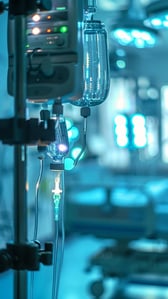GlaxoSmithKline Plc (LON:GSK) ViiV Healthcare today presented comprehensive 48-week data from the ATLAS (Antiretroviral Therapy as Long-Acting Suppression) and FLAIR (First Long-Acting Injectable Regimen) pivotal phase III studies of the novel, investigational, long-acting regimen of cabotegravir and rilpivirine. These two studies met their primary endpoints, showing that the combination of ViiV Healthcare’s cabotegravir and Janssen’s rilpivirine, injected every four weeks, was non-inferior in maintaining viral suppression in adults infected with human immunodeficiency virus type-1 (HIV-1) when compared to a standard of care, daily, oral three-drug regimen. These data were presented today at the 2019 Conference on Retroviruses and Opportunistic Infections (CROI) in Seattle, Washington.
John C. Pottage, Jr., M.D., Chief Scientific and Medical Officer of ViiV Healthcare, said: “With FLAIR and ATLAS, we now have positive results from two pivotal phase III studies demonstrating that this long-acting, once-monthly injectable regimen has similar efficacy, safety and tolerability to a daily oral three-drug regimen for the treatment of HIV. We are also encouraged by patient preference data showing that nearly all participants who switched to the long-acting injectable regimen preferred it over their prior oral therapy. If approved, this two-drug regimen would give people living with HIV one month between each dose of antiretroviral therapy, changing HIV treatment from 365 dosing days per year, to just 12. We look forward to submitting applications to regulatory authorities later this year.”
ATLAS 48-week efficacy and safety results
The global, pivotal, phase III ATLAS study met its primary endpoint, with cabotegravir and rilpivirine demonstrating non-inferiority to an oral three-drug regimen of two nucleoside reverse transcriptase inhibitors (NRTIs) plus a third agent, as measured by the proportion of participants with plasma HIV-1 RNA ≥50 copies per millilitre (c/mL) using the FDA Snapshot algorithm at Week 48 (cabotegravir + rilpivirine: 5/308 [1.6%], current antiretroviral therapy [CAR]: 3/308 [1.0%], adjusted difference: 0.6%, 95% confidence interval [CI]: -1.2, 2.5). The study found virologic suppression rates (HIV-1 RNA <50 c/mL) at Week 48 were similar between treatment arms (cabotegravir + rilpivirine: 285/308 [92.5%], CAR: 294/308 [95.5%], adjusted difference: -3%, 95% CI: -6.7, 0.7).
Confirmed virologic failure (CVF) was infrequent. Three participants (approximately 1% of the study population) who received long-acting cabotegravir plus rilpivirine developed CVF with subsequent identification of resistance mutations to one or both agents. In two of these cases, pre-existing NNRTI resistance was identified. Two of the three individuals were from Russia and all three had HIV-1 A subtypes, which are seen frequently in Russia, Eastern Europe and East Africa; however, they are seen infrequently in other parts of the world. This unexpected pattern warrants further investigation. In the oral CAR arm, there were four participants who developed CVF, three of whom developed drug resistance mutations.
Treatment with cabotegravir and rilpivirine was generally well-tolerated, with low rates of serious adverse events (SAEs) (13/308 [4.2%]) and adverse event (AE) withdrawals (10/308 [3.2%]). Of the participants who received cabotegravir and rilpivirine injections, 83% (250/303) reported an injection site reaction (ISR) at some point through the 48-week study. A majority of injections did not result in ISRs being reported, as out of a total of 6978 injections administered during the 48-week study, 1460 ISRs were reported. Most ISR events (98.5%) were mild or moderate (mild: 1156/1460, moderate: 283/1460) and lasted an average of three days. Four participants (1.3%) withdrew for injection-related events.
Patient treatment satisfaction significantly improved after switching to the long-acting injectable from the previous oral therapy compared to remaining on oral therapy at Week 44 based on the HIV Treatment Satisfaction Questionnaire (HIVTSQs mean difference 5.68; 95% CI [4.37, 6.9]; p<0.001). Patient preference data from a single-item question administered at Week 48 showed that 266/308 (86.4%) preferred the long-acting injectable regimen whereas 7/308 (2.3%) preferred their previous oral therapy.
Susan Swindells, MBBS, Professor, Department of Internal Medicine, Section of Infectious Diseases at the University of Nebraska Medical Center and ATLAS principal investigator, said: “The positive safety and efficacy results from the ATLAS study reinforce the potential of cabotegravir and rilpivirine as the first long-acting, injectable option for people living with HIV. This novel approach may help alleviate the burden often associated with daily oral treatment regimens and contribute to making HIV a smaller part of peoples’ lives.”
FLAIR 48-week efficacy and safety results
The global, pivotal, phase III FLAIR study met its primary endpoint, with cabotegravir and rilpivirine demonstrating non-inferiority to Triumeq (abacavir/dolutegravir/lamivudine-ABC/DTG/3TC), as measured by the proportion of participants with plasma HIV-1 RNA ≥50 c/mL using the FDA Snapshot algorithm at Week 48 (cabotegravir + rilpivirine: 6/283 [2.1%], Triumeq 7/283 [2.5%], adjusted difference: -0.4%, 95% CI: -2.8, 2.1). The study found virologic suppression rates (HIV-1 RNA <50 c/mL) at Week 48 were similar between treatment arms (cabotegravir + rilpivirine: 265/283 [93.6%], Triumeq: 264/283 [93.3%], adjusted difference: 0.4%. 95% CI: -3.7, 4.5).
CVF was infrequent across both treatment arms. Of the individuals who received long-acting cabotegravir plus rilpivirine, there were three confirmed virologic failures (approximately 1% of the study population), all of whom had treatment-emergent, NNRTI and INSTI resistance. All of these individuals were from Russia and had HIV-1 subtype A1, which is seen frequently in Russia, Eastern Europe and East Africa; however, it is seen infrequently in other parts of the world. This unexpected pattern warrants further investigation. Three participants in the Triumeq arm developed CVF with no treatment emergent resistance.
Treatment with cabotegravir and rilpivirine was generally well-tolerated, with low rates of SAEs (18/283 [6.4%]) and AEs leading to withdrawal (9/283 [3.2%]). Of the participants who received cabotegravir and rilpivirine injections, 86 percent (239/278) reported an ISR at some point through the 48-week study. A majority of injections did not result in an ISR being reported, with a total of 7704 injections administered during the 48-week study resulting in 2203 ISR events. Nearly all ISRs (99.4%) were mild or moderate (mild: 1907/2203, moderate: 282/2203), with a median duration of three days and the frequency of these events decreasing over time. Four participants (1.4%) withdrew for injection-related events.
Patient treatment satisfaction significantly improved after switching to the long-acting injectable from the previous oral therapy compared to remaining on oral therapy at Week 48 based on the HIV Treatment Satisfaction Questionnaire (HIVTSQc mean difference 4.1; 95% CI [2.8, 5.5], p<0.001). Patient preference data from a single-item question administered at Week 48 showed that 257/283 (90.8%) preferred the long-acting injectable regimen whereas 2/283 (0.7%) preferred their previous oral therapy.
Chloe Orkin, M.D., Consultant Physician and Clinical Professor at Queen Mary University of London and FLAIR principal investigator, said: “The robust results of the FLAIR study lend further evidence to the potential of cabotegravir and rilpivirine as an alternative option for people currently on daily, oral therapy. This long-acting, injectable two-drug regimen may provide an opportunity to change the paradigm for people living with HIV by breaking the cycle of a daily pill, which has been a defining characteristic of HIV therapy for several decades.”
In addition to the once-monthly dosing schedule being evaluated in the ATLAS study, ViiV Healthcare is investigating the long-acting, two-drug regimen of cabotegravir and rilpivirine administered every two months in the ATLAS-2M study. The company plans to use the data from the FLAIR and ATLAS studies for future regulatory submissions.
This investigational, long-acting, injectable regimen is being co-developed as part of a collaboration with Janssen Sciences Ireland UC and is not approved by regulatory authorities anywhere in the world.










































